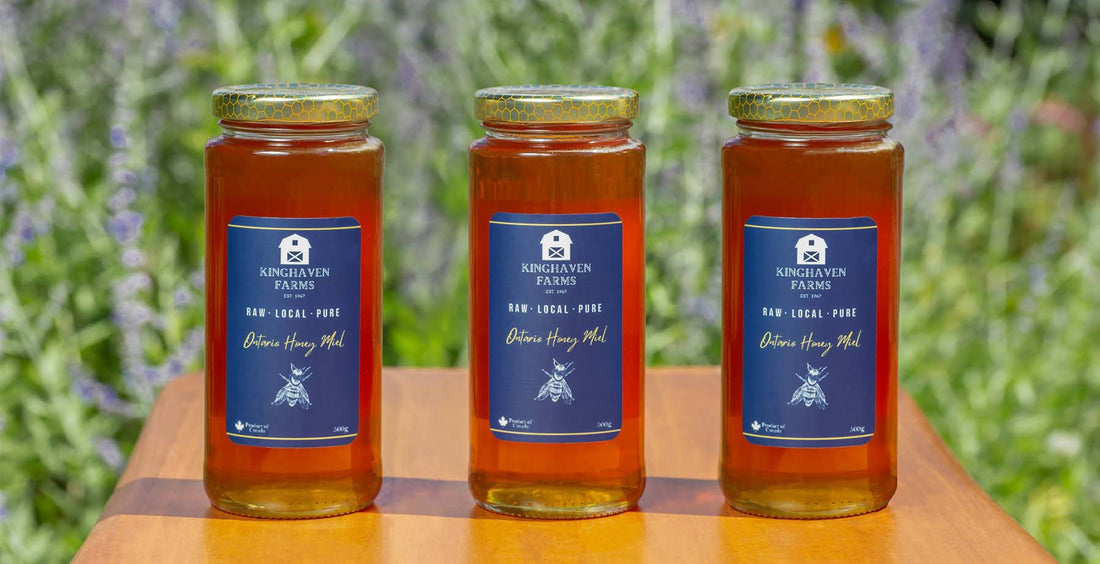Ever wonder why honeycomb isn’t round or how honey is similar to wine? These 12 compelling facts will give you a new appreciation for the golden superfood and the magical little creatures that make it.
1. Honey is a major target for food fraud.
There’s a surprising amount of fake honey out there. The Canadian Food Inspection Agency (CFIA) found that almost 22% of imported honey samples were cut with corn syrup and other cheap sugar syrups. This lets dishonest producers and importers stretch their honey with cheap additives to undercut reputable producers.
So, how do you keep yourself from falling prey to fake honey swindlers? For starters, try to buy directly from the source. Local honey producers stake their reputation on the quality of their products. They wouldn’t dream of adulterating their honey.
If you prefer to buy your honey at your local supermarket, you can still ensure authenticity. The same CFIA investigation found that 100% of Canadian-made honey is exactly what it claims to be — authentic honey. So the next time you’re roaming the aisles, look for a “Product of Canada” label to make sure you’re getting the real deal.
2. Honey’s a natural healer.
The ancient Egyptians used honey in wound care thousands of years ago, and for good reason. Not only does it have antimicrobial and antibacterial properties, but its thickness and stickiness also provide a barrier to protect wounds as they heal.
Modern medicine is increasingly catching on to honey’s potency. A number of companies now make honey-infused bandages to help promote wound healing and stave off infection. Best of all, research shows they can even speed up healing time.
3. Honeycomb is intentionally hexagonal.

Honeycomb isn’t just lovely to look at — its six-sided hexagonal shape is intentional. For starters, hexagons fit together precisely. If honeycomb was made from circles instead, they wouldn’t fit together perfectly. And, for the sake of structural integrity, bees would have to fill the resulting gaps with beeswax, an energy-intensive product.
So, why not triangles or squares instead? While the straight sides of these shapes fit together exactly, they spark a different concern.
Hexagons are closer to a circle than squares or triangles. That means that when all three shapes have the same inner space — aka area — the hexagon has the smallest perimeter of the three. In other words, it’s maximized for storage, while being the least resource-intensive shape to build.
No, bees haven’t been taking advanced math. Over time, natural selection favoured colonies that built the strongest hives while simultaneously conserving resources and maximizing space. That means the hexagon won out.
4. Honey can help you regulate your blood sugar.
Despite being sweet, honey’s low on the glycemic index (GI) so it won’t spike your blood sugar. Moreover, digesting honey may increase your cells’ sensitivity to glucose, helping them to better manage your blood sugar.
It may hold even more promise for individuals with type 1 diabetes — an autoimmune disease that causes the host’s immune system to attack the cells of its own pancreas. Research shows that honey may help stimulate these diseased pancreatic cells, helping them to regain proper function.
This makes honey a great sugar alternative for anyone trying to manage their blood glucose or reduce their sugar intake.
5. Honeybees use their wings for more than just flight.
The wings of honeybees are a mini-miracle of natural engineering, seemingly too small to enable bees to take flight. However, not only do they take these buzzing beauties skyward, they also serve some crucial functions in the hive.
Bees have two sets of wings on each side which they’re able to flap more than 200 times a second. Outside of flight, they do this to regulate the temperature inside their hive, control humidity, and cure the honey.
Nascent honey starts off with a high moisture content. However, as the bees flap their wings, it creates a current of warm air. This pleasant breeze helps hasten the evaporative process, turning the collected nectar into the honey you know and love.
Since warm air holds more water than cool air, it gobbles up some of the excess moisture in the hive. And, the continuous wing fluttering helps to move that moist air out, taking the excess humidity with it.
6. Honey works just as well as cough medicine — maybe even better.
The next time you have a cough or sore throat, try soothing it with a spoonful of honey. Research shows that this provides just as much relief from symptoms as taking over-the-counter cough medicines.
Using honey in place of cough medication is especially helpful if you have little ones. For starters, your child is probably only too happy to swallow something sweet. More importantly, it’s not advisable and can be downright dangerous to give cough medicine to kids under six.
While honey is both a safe and effective remedy, it shouldn’t be given to children under 12 months old. Honey can sometimes contain clostridium botulinum spores. While this naturally occurring bacteria doesn’t pose a danger to older kiddos or adults, it can cause severe health issues for babies under a year of age.
7. Honey flavours can be as complex as wine.
Like wine, honey has terroir — a distinct taste imparted by its environment. And, seasonality, geography, and aging all contribute to its flavour and colour.
You’re most likely to find wildflower honeys in Canada which tend to be sweet and a little more robust. Clover honey, in contrast, evokes a milder note. But, there’s a large assortment of honey beyond these more traditional ones.
Single varietal honeys, made from one source have distinct flavour profiles. For example, orange blossom honey tastes like citrus, while Manuka honey has a downright medicinal tang. And, like wine and whisky, honey can also be aged, sometimes in alcohol casks, which imparts further intricacies to its flavour.
Honey colour can vary immensely as well, as flowers come in and out of season. It can span all the way from pale — so-called “water white” — to dark amber. The murkiest versions often come from dark brown buckwheat flowers and can range from brown to purple to black.
Beyond that, honey can be prepared in different ways including whipping or creaming it which produces a smooth and spreadable texture. But, whichever way you choose to eat it, its deliciousness remains.
8. Honey is sweeter than sugar.
You can use honey anywhere you would sugar, but because it’s sweeter, you’ll need less of it. For every one cup of sugar, you can substitute ⅔ of a cup of honey. Just make sure to reduce the amount of liquid in your favourite recipes by about a quarter cup to make up for it.
Beyond that, honey will help you achieve that beautiful toasted golden colour sooner, so consider reducing heat by 25°F to account for this. Finally, honey functions as an acid when it comes to baking. If your recipe calls for another acid like buttermilk or lemon juice, balance out the ph by adding a ¼ teaspoon of baking soda to the mix.
9. Honey’s great for hangovers.
It almost seems too good to be true, but swallowing a teaspoon of honey can help you recover faster after a night out.
Alcohol spikes your blood glucose before causing an epic crash, which triggers the fatigue and headache symptoms associated with a hangover. Rather than repeating this cycle of spike and crash with a hangover fry up of starchy, greasy foods, try some honey instead. Honey is absorbed slowly, which helps to keep your blood sugar stable.
Moreover, honey can actually help your body process alcohol more efficiently. This won’t cure your hangover completely, but it may speed up your recovery and reduce the severity of your symptoms.
10. Honey’s amazing for your skin.
Using honey in skincare can address a multitude of different skin conditions, from acne to dry and sensitive skin.
As a humectant, honey attracts and binds water molecules to itself, helping your skin to retain moisture. Beyond that, it’s antibacterial, making it an efficient way of getting rid of bacteria on the skin. It does all this while being non-comedogenic, so it won’t clog your pores.
This unique collection of features makes honey an ideal ingredient for skincare products, imparting your skin with a natural and healthy glow. As an added bonus, it smells amazing.
11. A queen bee lays between 1,500-2,000 eggs a day during her life.
The queen bee starts her life genetically identical to other worker bees. However, her diet rapidly differentiates her from her sisters. Bee larvae start their lives on a short-lived diet of royal jelly. After two or three days of the substance, they switch to a diet of pollen and honey.
The queen makes no such switch — she continues to eat royal jelly, and its superior nutrition changes her dramatically.
Not only does the queen grow significantly larger than the other colony members, she also develops sexually — laying thousands of eggs a day. Perhaps most interesting, however, is the increase in her lifespan. Worker bees live 15-38 days in the summer, to a maximum of 200 days in the winter. The queen? An average of one to two years.
12. Honey’s nutritional benefits are only applicable to raw honey.
Raw honey is a nutritional powerhouse packed with vitamins, proteins, and fatty acids. However, much of the honey you find on the supermarket shelf is pasteurized. Pasteurization exposes the honey to high heat, removing many of its antioxidant, antibiotic, and anti-inflammatory properties.
Pasteurization is necessary for milk as it kills bacteria and microorganisms that can cause illness or spoilage. But you don’t have to be worried about germs when it comes to honey. Its natural antimicrobial properties prevent most yeasts and bacteria from spoiling it.
Additionally, raw honey contains small particles of pollen, beeswax, propolis, and royal jelly. These bee-made substances come with a whole host of additional health benefits, increasing the potency of raw honey. The next time you’re shopping for honey, look for the term “raw” on the label to maximize its health benefits.




